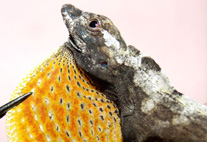Abstract
We describe the new species Norops triumphalis sp. nov. from Darién, Panama. Norops triumphalis differs from all congeners by having a combination of (1) smooth, bulging, subimbricate ventral scales; (2) a short tail, ratio tail length/SVL 1.54; (3) short hind legs, longest toe of adpressed hind leg reaching to ear opening, ratio shank length/SVL 0.24; (4) a lichenous body pattern; and (5) a very large yellowish orange dewlap in males. In external morphology, N. triumphalis is most similar to the species of the N. pentaprion group. Norops triumphalis differs from the other species in the N. pentaprion group, except N. sulcifrons, by having a very large orange male dewlap (vs. a large red or pink dewlap) and an unpigmented throat lining. Norops triumphalis differs from N. sulcifrons by having the supracaudal scales not forming a serrated crest (vs. a distinct serrated caudal crest present in N. sulcifrons), 4 supracaudal scales per segment (vs. 3 supracaudal scales per segment in N. sulcifrons), greatly enlarged outer postmental scales, about four times the size of adjacent medial scales (vs. moderately enlarged outer postmental scales, about twice the size of adjacent medial scales, in N. sulcifrons), and no enlarged postcloacal scales in males (vs. a pair of moderately enlarged postcloacal scales present in male N. sulcifrons). We further provide a standardized description and illustrations of the holotype of N. sulcifrons.

